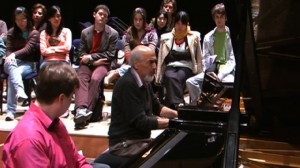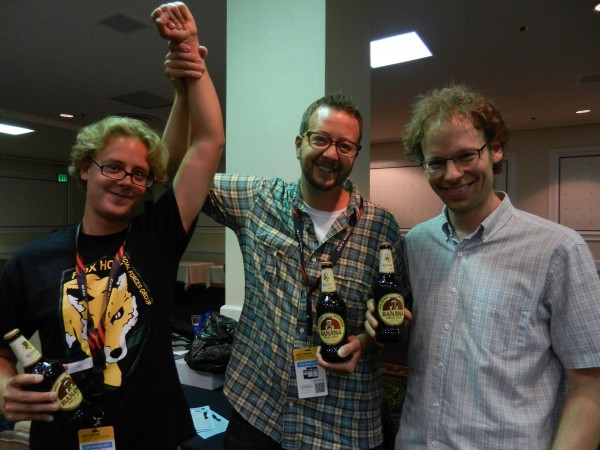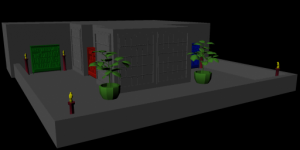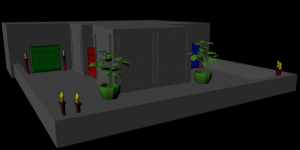I had totally forgotten about the bet, but it’s clear I lost it, fair and square:
“Didn’t I bet you in my invitation to evo last year that an evo guy would become your #1 player? I want a beer, or at least some opportunity to be smug somehow :)” – Seth Killian
I had just emailed Seth, Tom Cannon, and Nathan Vella about SpyParty at Evo 2013, the premier fighting game convention and tournament. If you recall, we had a great time at Evo 2012, and we’re going to be back again this week, at the Paris Hotel & Casino, Las Vegas, July 12-14. SpyParty is part of the Evo Indie Showcase, which is this awesome thing where they invite competitive multiplayer indie games to set up at the show so the Fighting Game Community (FGC) can check them out. You can see the list of returning games from last year here, and the list of new games for this year here.
I was mailing those guys because I’d just realized that kcmmmmm (a.k.a. Korey Mueller) had taken the #1 spot on the SpyParty leaderboard about a month previously, and he had told me he’d first seen the game at Evo 2012, and kcmmmmm also lives in Las Vegas, and is going to be helping out at the booth on Friday, the 12th! I figured I’d let those guys know; hey, wasn’t that neat? That was when Seth reminded me of the bet from his March 16th, 2012 invitation:
“If you take me up on it, I’d even be willing to make a gentleman’s bet with you that an that an EVO attendee will be your #1 player in subsequent tests, and take down whoever the existing top players might be. I dunno which one, but I trust implicitly in these guys as a group.”
Welp.
In honor of losing this bet, of Seth’s prescience about the FGC, of flying to Evo 2013 tomorrow, and of kcmmmmm‘s leaderboard ascendance and his Friday presence at Evo, I decided to interview him about his history with fighting games, Evo, and SpyParty.
You can follow kcmmmmm on twitch.tv, where he plays some great high-level SpyParty games with live comments at http://twitch.tv/kcmmmmm
kcmmmmm
Why don’t we start with you giving me a bit of backstory about you and Evo and the FGC and whatnot? How many Evos have you been to, how’d you get into it, which fighting games do you like, why, how’d you hear about SpyParty, what’d you think of the Indie Showcase last year, etc.
I started gaming at a pretty young age, but never had a large selection of games until I got older and could afford my own. So, I was stuck with whatever few games I already had on SNES, one of which was Street Fighter 2. My brother and I were BAD. I really didn’t play many more fighting games until a friend introduced me to the Guilty Gear series. From there I was hooked on the game, and played it almost religiously with anyone I could find. Unfortunately, that was very few people. Only a few of my friends were into fighter’s, so it wasn’t until BlazBlue came out in 2008 that I finally was able to consistently find people to play online. I had played a lot of non-fighters online in the past…primarily Counter-Strike. The fighting community is so different. Since fighters rely on more than a purely twitch-response skill set, fg players tend to be more knowledgeable about the games they play. In a shooter, you only need to know map layout, relative weapon strengths/weaknesses, and how to quickly shoot someone in the head the second you see them. In fg’s, success depends on a large variety of information, most of which is not immediately apparent or available. Essentially, you need to learn which moves have higher priority, what moves can gatling or combo into each other, safe blockstrings, move properties (which usually depend on knowing the core game system), just to name a few. And just knowing it for your own character isn’t enough. Players have to learn the relative matchups, so they know their own strengths and weaknesses in any situation. The information requirement is incredibly high, so the community works together to gather all of the pertinent information. Players break down the games on a frame-by-frame level, and make that information available to everyone. The community sort of reflects this togetherness, and individual members just seem more interested in talking about their favorite games on a deeper level than players in other genres. It’s a great community because players work so hard to help each other improve – to help their opponents improve. I met some of my best friends today playing fg’s online, and even more than the games themselves, the community has kept me into the genre.
My favorite series is the Guilty Gear series. I’ve never been particularly good at it (mainly because of a lack of a decent online version). But since it reintroduced me to fg’s, it will always have a special nostalgia for me. The game has an amazing style, and matches are intense and fun. In general, I like 1v1 air-dash fighters most. Guilty Gear, BlazBlue, Persona 4 Arena (P4A), Skullgirls also counts (sort of). I like being able to dash right in and get overly aggressive on defending opponents with mixups. I usually play to one of two extremes. Either I play a slow, beefy character (like a grappler), or a quick aggressive character.
But there’s something special about the slower paced fighters that air-dash fighters lack. I was actually surprised at how much I enjoy Street Fighter 4. A lot of people complain that the game is all about footsies, and less about actual combat. It’s true, but the tension of slowly sussing out your opponent, poking at air to bait mistakes, predicting jump-ins with anti-air attacks…all of that lends this kind of chess-like feel. You don’t really get that in quicker paced games. Any good fighter allows for deep opponent-reading, but SF4 seems to hit a higher level by giving players the time to think. Somehow it strikes that perfect balance between action and meditation. At any given moment, when you’re down and almost out, you can come back with a series of perfectly read and executed responses. It’s possible in faster games…but seems more unlikely.
I enjoy watching team fighters like MvC more than playing. There’s just too much stuff going on the screen. It just feels less personal when you take away the 1v1 mechanic.
Last year’s EVO (2012) was the first I ever attended. It was…incredible. A few friends from all over the US flew in, and we spent the weekend beating each other up. I think we spent most of our time playing P4A, since it hadn’t been released yet, and we were hyped to check it out. My favorite part of EVO had to be the finals. Particularly the King of Fighters 13 finals…that game brought some amazing competition, and was so fun to watch.
As for the indie showcase, there were a few interesting games there. I remember playing a My Little Pony fg…which was actually pretty fun. DiveKick was surprisingly awesome. I thought it was going to be a bit of a joke, but it’s actually pretty damn competitive. It sort of cuts out all of the flashy combos and super moves, and instead focuses entirely on the guessing game. The loser is always the person who loses their cool and jumps or dives first, or waits too long to dive after a jump. It’s like a tribute to the pissing match. I remember playing Aztez as well. It’s a side-scrolling beat-em-up with stylized black and white (and very, very red) visuals…the combat system is actually pretty similar to a fighting game’s: you can combo, grab, air juggle, and just beat helpless enemies senseless.
However, of all of the games at EVO, one in particular caught my eye. In the midst of all of these high tech and visually-stunning games (right across from PS All-Stars’ booth, if I recall) was this sort of ugly game which looked like The Sims from 2002. I’m not a graphics whore or anything, but the game just felt very out of place. It seemed as far removed from fighting games as was possible. It caught my eye immediately. I wandered over, and there’s just this table of pamphlets and a sign telling me to read the manual first. Read the manual? What? So I pocketed a manual to read later, walked up to the guy standing next to the table, and asked “So…what am I looking at here?” I didn’t know you were the creator of the game, but you laughed and explained the game to me, and I immediately loved the idea. A slow paced 1v1 game where the players are given the time to suss out an opponent’s actions and respond? Kind of sounds a bit familiar actually.
On the topic of learning character-specific information in fighters you mention above, I can’t remember if you’re a fan of the “dossiers” idea for SpyParty, where the different characters have different backgrounds and biases, so the General might drink too much every night, Girta might be obsessed with statues, etc., but what do you think of this (or some variant on this) with respect to the amount of study necessary to get good at a fighting game? More generally, how do you feel about having to do “homework” for games?
Well, originally I was against the “dossier” idea. I still don’t think it would make sense in the current state of the game, but when the new art is implemented, and characters all have unique traits, animations, and personalities, it makes sense to include that personality into the gameplay. As for how this relates to studying in fighting games, it’s hard to say. Research in a fighting game is very different than SpyParty; it involves spending an amount of time honing combos, practicing hit confirms, learning what your character is capable of (and how they match against opposing characters), testing defensive options, gimmicks, traps, etc. A lot of this time is spent with a direct hands-on approach, interspersed with finding and learning tech from other players, which you then practice yourself. Learning character traits in SpyParty might end up being equally time consuming, but I think most of that time would be spent observing the “natural state” of the AI, and learning their behaviors. Since micro is largely a non-issue in the game (compared to fighters), learning AI behavior would be paramount to taking advantage of the “dossier” concept. In a way, I think this actually might be more difficult information to gather, because it’s more entertaining to learn stuff by actually directly tackling it than simply watching it unfold in the game on its own. Eventually, players will make most of that information available to everyone, so you’ll be able to find it online without having to do all of the work, but reading (or observing) that information and applying it in a game are very different. I don’t mind doing homework for games, so long as there is a reward at the end of it. If players put hundreds of hours into studying the “dossier” behaviors, but are unable to apply that to real games, then it will have failed as a feature. So it needs to be deep and effective to ensure that players benefit from doing their homework.
I assume you did not have a clear idea that a year later you would be at the top of the leaderboard. How did you go from pocketing the manual to becoming so passionate about SpyParty? Was there a point where you said to yourself “I want to be one of the top players of this game?”, or do you do that for any game you really like, or did you look up one day and realized you’d played 6000+ games, or what? Basically, what’s your arc in SpyParty?
I hadn’t heard of SpyParty before EVO, but I was just immediately blown away by the concept. This is a really cool idea! I signed up for the beta a few days later, and realized then that the beta was closed and there was a waiting list. A really long waiting list. So, I just did what I could to follow the game here and there, reading news updates and waiting for my invitation. From what I could tell, the game’s community was really blossoming into something special. There was a lot of talk about expert players mentoring newbies, and people just being generally pleasant. I guess my main goal, even before getting in, was to be a positive member of the community myself when I finally did get in. Somehow, that translated into getting to know all of the veterans, who were happy to mentor me along the way, and helping along players newer than myself. Next thing I knew, I was playing on even footing with the players who had mentored (and destroyed) me not so long ago. There’s always this feeling that there’s some way I can improve, and every time I meet a personal goal, I find another one. I couldn’t really look at the game and decide to be a top player, I just wanted to continue to improve…and at some point, I guess I got pretty decent at it. Now that you mention it, 6000 games is a lot.
Can you compare and constrast the SpyParty community and the FGC? Not in a “which one’s better” sense, but what are the similarities and differences, what can SpyParty learn from the FGC, etc.
Well, obviously the biggest difference between the two communities is that the FGC is a genre community, whereas SpyParty‘s is a singular game community. So, when you compare SpyParty‘s community to all of FG’s, you find that there is just an enormous amount of diversity in interests within the FGC. Everyone who plays and gets involved in SpyParty has this one game in common, but being a part of the FGC is a much more broad category. There are a lot of differing opinions on what FG’s are best, where most players prefer one style of game over another, and half the time they don’t agree. Sometimes it can get pretty ridiculous, but for the most part, everyone gets along. There’s a lot of diversity in player preference, and a general acceptance of that fact within the overall community. For the most part, players are willing to help each other out more often than put each other down. Ultimately, I think the longevity of the community is probably the biggest difference between SpyParty‘s community and the FGC. Considering the increasing number of games, wide variety of players from all over the world, and tens of years of development, the community is still incredibly strong and continues to encourage diversity. If the SpyParty community can learn anything from that, it’s to continue to work towards helping other players develop, and continuing to work to maintain the quality. This means nurturing each new member as a valuable part of the community, and teaching each of them to uphold the high standards we set for it and ourselves right now.
Did I get you in any of the Evo 2012 pics?
You actually did get me, in one picture. I’m the guy in the blue shirt and glasses, standing behind the center table. Hands in pockets, looking around confused.
http://www.spyparty.com/2012/07/13/spyparty-at-evo-2012-pics/#lightbox=dscn1536.jpg
kcmmmmm, by the numbers
“Now that you mention it, 6000 games is a lot.”
| Username |
Total Matches |
Match Time |
Total Games |
Game Time |
Login Time |
| kcmmmmm |
709 |
416:38:23 |
6436 |
262:00:48 |
1020:02:24 |
| As Spy |
| Total Spy Games |
Total Spy Wins |
Mission Wins |
Timeouts |
Sniper Shot Spy |
Sniper Shot Civilian |
| 3179 |
1690 |
837 |
70 |
1419 |
853 |
| As Sniper |
| Total Sniper Games |
Total Sniper Wins |
Shot Spy |
Shot Civilian |
Spy Mission Wins |
Spy Timeouts |
| 3257 |
2248 |
2052 |
556 |
453 |
196 |
Here’s the current Top 10:
| Username |
Total Games |
Game Time |
Total Spy Wins |
Total Sniper Wins |
| kcmmmmm |
6436 |
262:00:48 |
1690 |
2248 |
| sawchuk1 |
5151 |
212:48:25 |
1745 |
1435 |
| drawnonward |
5056 |
195:34:58 |
1201 |
1207 |
| virifaux |
4429 |
130:44:51 |
998 |
1166 |
| r7stuart |
4324 |
162:48:13 |
1432 |
1580 |
| tytalus |
3692 |
142:42:20 |
1049 |
1184 |
| scallions |
3685 |
147:24:33 |
980 |
1031 |
| james1221 |
3506 |
150:39:27 |
882 |
1252 |
| zerotka |
3467 |
143:43:11 |
733 |
1025 |
| turnout8 |
3437 |
138:26:09 |
808 |
920 |
A couple notes about the current SpyParty leaderboard, since it’s a little bit different from a lot of games:
- Right now, SpyParty ranking is based on total games played. I don’t have a skill-based ranking algorithm implemented yet, but because most elite players agree we haven’t found the skill-ceiling for the game yet, the number of games played is fairly well correlated with skill, at least to a first approximation. A lot of the top players play mentoring games with newbies, and other wacky player-created alternative game modes for fun, so the number of games isn’t a perfect indicator of skill, but if you’re at the top of the leaderboard with thousands of games played, you are really really really good at SpyParty, way better than me, and I wrote the game. kcmmmmm can hand me my ass without trying very hard on his worst days.
- There is another player, virifaux in the above top-10, who is an alt started about halfway through the player’s SpyParty career, and if we add virifaux and viriflod (his original username) together, they’re actually the highest ranking player, and kcmmmmm is 2nd ranked! This is an issue sports don’t have to deal with. “Hey, isn’t that Tiger Woods with a fake mustache?”











